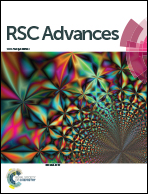Long-term monitoring of capase-3 activity in living cells based on the FRET probe composed of quantum dot, nanogold and EGF
Abstract
Conventional probes used to detect proteases are susceptible to either photobleaching or low efficiency in cell penetration. Also it is difficult to achieve multiplexed detection. Based on QD, nanogold and EGF, a unique probe was studied in this paper. The sensing section of the probe was developed by linking the streptavidin-labeled QD and monomaleimide-functionalized nanogold via a substrate peptide. The QD fluorescence is partially quenched by the nanogold when they are connected. After the substrate peptide is cleaved by protease, the QD fluorescence can be partially recovered as the distance between two kinds of nanoparticles increases. Biotin-labeled EGF was used to carry the sensing section into the cells, making the transfection efficiency higher than former nanoprobes. After assays, we found the optimal ratios of nanogold to QD and to EGF to realize the high efficiency of both quenching and transfer. Also an algorithm was proposed to evaluate the relative activity of proteases. Finally, caspase-3 was used as the target protease to be detected. The activity of caspase-3 was successfully monitored during a longer time span compared to the reported probes.


 Please wait while we load your content...
Please wait while we load your content...